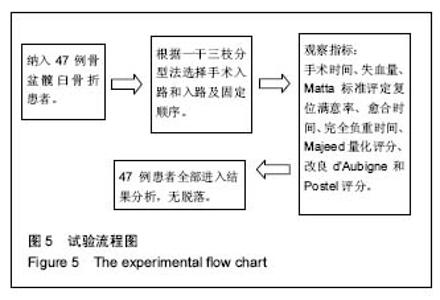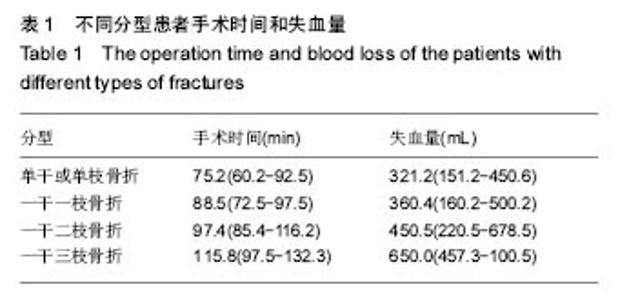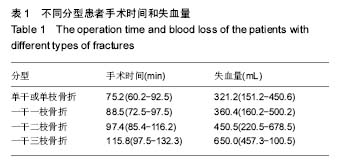| [1] Tile M. Acute pelvic fractures: I. causation and classification. Am Acad Orthop Surg.1996;4(3):143-151.[2] George P, Petros A, Byron C, et al. Surgically treated acetabular fractures via a single posterior approach with a follow-up of 2-10 years.injury.2007;38:334-343.[3] Matta JM, Saucedo T. Internal fixation of pelvic ring fractures. Clin Orthop Relat Res. 1989;(242):83-97.[4] Matta JM. Fractures of the acetabulum: accuracy of reduction and clinical results in patients managed operatively within three weeks after the injury. J Bone Joint Surg Am.1996;78: 1632-1645.[5] Majeed SA. Grading the outcome of pelvic fractures. J Bone Joint Surg Br.1989;71:304-306.[6] D’Aubigne RM, Postel M. Functional results of hip arthroplasty with acrylic prosthesis. J Bone Joint Surg Am. 1954;36:451-475.[7] Pennal GF, Tile M, Waddell JP, et al. Pelvic disruption: assessment and classification. Clin Orthop Relat Res.1980; (151):12-21.[8] Lansford JR, Burgess AR, Liporace FA, et al. Pelvic fractures: part2.Contemporary indications and techniques for definitive surgical management. J Am Acad Orthop Surg.2013;21: 458-468.[9] Hirvensalo E, Lindahl J, Bostman O. A new approach to the internal fixation of unstable pelvic fractures. Clin Orthop Relat Res.1993;(297):28-32.[10] Cole JD, Bolhofner BR. Acetabular fractures fixation via a modified Stoppa limited intrapelvic approach. Clin Orthop Relat Res.1994;(305):112-123.[11] Hirvensalo E, Lindahl J, Kiljunen V. Modified and new approaches for pelvic and acetabular surgery. Injury.2007; 38(4):431-441.[12] Keel MJ, Ecker TM, Cullmann JL, et al .The Pararectus approach for anterior intrapelvic management of acetabular fractures: an anatomical study and clinical evaluation. J Bone Joint Surg Br.2012;94(3):405-411.[13] Hyoung-Keun O, Kyu C S, Jung-Jae K, et al. Stoppa Approach for Anterior Plate Fixation in Unstable Pelvic Ring Injury. Clin Orthop Surg. 2016; 8(3):243-248.[14] 李绪松,罗维维,郑臣校. 改良Stoppa入路在髋臼前柱骨折内固定术中的应用[J]. 中国骨与关节损伤杂志, 2016, 31(s1):83-84.[15] Elmadag M, Guzel Y, Aksoy Y, et al. Surgical Treatment of Displaced Acetabular Fractures Using a Modified Stoppa Approach. Orthopedics. 2016;39(2): e340-345.[16] Bastian JD, Ansorge A, Tomagra S, et al. Anterior fixation of unstable pelvic ring fractures using the modified Stoppa approach: mid-term results are independent on patients' age. Eur J Trauma Emerg Surg. 2016;42(5):1-6.[17] 李贵坚,陈亚洲,刘培倦,等. 改良Stoppa入路治疗髋臼前部骨折[J]. 中华创伤骨科杂志, 2017,19(2):173-175.[18] 欧艺,杨洪昌,陈戈,等. 改良Stoppa入路[J]. 创伤外科杂志, 2016, 18(4):252-255.[19] Wang DC, Kui LI, Cao PK, et al. Anatomic study of safe zone for screw insertion around the acetabulum in stoppa approach. J Henan Med Coll. 2017.[20] Bai Z. Comparison of clinical effects of modified Stoppa approach and ilioinguinal approach surgery in the treatment of pelvic and acetabular fractures. China Modern Doctor. 2016.[21] Liu Z, Chen B, Wang H, et al. Comparison of traditional indirect inguinal approach and improved Stoppa approach in treatment of pelvic and acetabular fractures. China Med Pharm. 2016.[22] 李宝丰,陈蓓,李梅,等. 应用改良Stoppa入路手术治疗骨盆髋臼骨折的疗效分析[J]. 中国骨与关节损伤杂志, 2016, 31(10): 1009-1011.[23] Yang ZY, Tao WU, Orthopaedics DO. Treatment of acetabular fracture with open reduction and internal fixation via modified Stoppa surgical approach. J Clin Orthop.2016.[24] 李民,李书奎,陈汉文,等. 新型改良Stoppa入路治疗髋臼并同侧骨盆骨折效果[J]. 齐鲁医学杂志, 2016,31(5):584-586.[25] Kim JW, Shon HC, Park JH. Injury of the obturator nerve in the modified Stoppa approach for acetabular fractures. Orthop Traumatol Surg Res. 2017.[26] 刘巍,闫国富. 改良Stoppa入路在骨盆髋臼骨折前方手术中的应用[J]. 中国药物与临床, 2016, 16(1):93-95.[27] 刘华水,段升军,刘士懂,等. Stoppa入路手术治疗骨盆前环骨折合并后尿道断裂[J]. 山东大学学报(医学版), 2016, 54(8): 88-91.[28] 李宗原,王陶,石波,等. 髂腰固定治疗合并骶骨骨折的垂直不稳定型骨盆骨折[J]. 四川医学, 2016, 37(4):433-437.[29] 熊绪,徐敏,邹鸿星,等. 改良Stoppa联合Kocher-Langenbeck入路在复杂髋臼骨折手术治疗中的应用[J]. 中国骨与关节损伤杂志, 2016, 31(10):1062-1063.[30] 张晋. Stoppa入路与髂腹股沟入路在髋臼骨折中的应用对比分析[J]. 创伤外科杂志, 2016, 18(9):570-571. |



